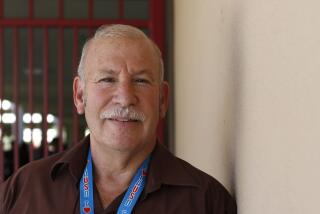PERSPECTIVE ON L.A. SCHOOLS Main Head Goes Here) : No matter how many districts a breakup might produce, students would still be bused. Parents would have no vote.
- Share via
Anna Gonzales gets to her local elementary school in South Gate by 6:30 every morning to board a bus that will take her to school. In South-Central Los Angeles, Robert Davies does the same. Both children have a one-hour bus ride ahead of them to get to school in the San Fernando Valley. Understand why they are doing this and you will understand why current efforts to break up the Los Angeles Unified School District are bound to fail.
When Anna’s parents moved to South Gate two years ago, they tried to enroll her in the neighborhood elementary school. They were told that the school was already at maximum capacity on a four-track, year-round program. Anna would have to attend an elementary school in the West San Fernando Valley that had room.
There is room for Robert at his local school. However, under the school district’s permit program, his parents elected to have Robert attend school in the Valley.
There now are 56,000 Annas and Roberts (fictional names for typical children in this category) attending schools in locations other than their local neighborhoods. Every day, tens of thousands are transported from the east, south and central areas of the district to Valley and Westside schools. What would be their fate if LAUSD were broken up? Would the multitude of new district boundaries prevent them from completing their education in their current schools? What about the new Annas, whose neighborhood schools still would not have enough room? Would they be forced into a year-round, double-session program?
In a word, the answer is no. The transportation programs that Anna and Robert participate in grew out of efforts to comply with Supreme Court integration decisions. The purpose was broadened to improve educational opportunities and reduce overcrowding. Breaking up the district would not eliminate that requirement; newly created districts would have to comply with court mandates. In fact, most advocates of splitting up L.A. Unified agree that these youngsters must be allowed to continue at their host schools. The same logic dictates that as new students enroll, they must be allowed similar enrollment opportunities across district boundaries.
But this creates a dilemma. Thousands of parents will be voting for school board representatives in a district different from the one their children attend. So, even though these parents are citizens and taxpayers, they have no say in the election of those who make policy for their children’s education. Will the parents of students like Robert who volunteer for magnet and permit programs understand that the price is their disenfranchisement? Will parents of students like Anna who are forced to attend distant schools understand this additional insult?
Forget about the difficulties of where and how many lines should be drawn, or what happens to bonded indebtedness and existing personnel. Forget for the moment the affront that is felt by those left in impoverished neighborhoods. The key problem that needs to be solved before mounting a serious effort to break up L.A. Unified is the lack of school facilities in the central and eastern portions of the district. In order to solve that problem, a major effort must be mounted to build and pay for the 30 new schools that are currently needed to eliminate existing overcrowding.
The risk in all of this discussion is that citizen concern about better management of the schools will be diverted into a fruitless battle to split up the school district instead of focusing on efforts to bring real decision-making power to the local school level. That’s where the critical problems will remain, whether LAUSD winds up as two, seven or a dozen districts.
More to Read
Sign up for Essential California
The most important California stories and recommendations in your inbox every morning.
You may occasionally receive promotional content from the Los Angeles Times.










